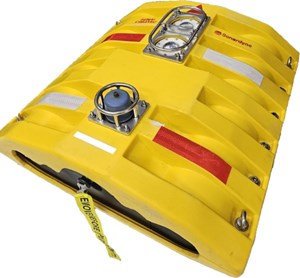Shell, Petrobras, partners pioneer “on demand” ocean bottom node monitoring project offshore Brazil
(WO) – Sonardyne announced the next phase of the pioneering On Demand Ocean Bottom Node (OD OBN) development project in Brazil. The project, which began in 2018, involves a collaboration between industry partners including Shell Brasil Petróleo Ltda, Petrobras and SENAI CIMATEC, and is supported under the Research Development and Infrastructure funding clause of the Brazilian National Agency for Petroleum, Natural Gas and Biofuels (ANP).

These nodes might lead to the next generation of geophysical monitoring systems in the offshore oil and gas industry. Using Sonardyne’s proprietary optical and acoustic communications technologies, and drawing on its extensive experience of seabed monitoring, OD OBN expects to provide a versatile, lower cost, more resilient solution for time-lapse seismic and subsidence monitoring of producing reservoirs with better data and the capacity to be placed on the ocean floor for up to five years without human intervention.
The idea is that data from these nodes can be extracted using Sonardyne’s through water optical communications system to a nearby Autonomous Underwater Vehicle such as Flatfish, which was developed by Saipem and SENAI CIMATEC under another ANP-funded program sponsored by Shell and Petrobras.
This latest phase was confirmed by the signing of contracts between SENAI CIMATEC and Petrobras in August 2023 and between Shell, SENAI CIMATEC, and Sonardyne in April 2024, to produce a pilot array of 600 prototype nodes expected to be deployed towards the end of 2025 at a preselected field offshore Brazil.
This pilot array will be manufactured at a newly created pilot plant facility constructed by SENAI CIMATEC at CIMATEC PARK, in an industrial region called Camaçari, close to the city of Salvador in Brazil.
The pilot plant has a design capacity to produce 600 nodes per year, featuring state of the art facilities including specialist parts machining and metals treatment, surface mount electronics production, a large and flexible manufacturing area and various environmental and functional testing apparatus, all of which are required to turn raw materials into completed nodes.
Shaun Dunn, Projects Director, Sonardyne, welcomed this latest project phase and commented, “We have been developing the enabling technologies for semi-permanent seabed seismic and subsidence monitoring nodes for over a decade and are therefore naturally delighted that they will soon be used in the world’s first large scale field wide test. Our sincere thanks go to our research partners in Shell, Petrobras and SENAI CIMATEC for supporting this program since its inception several years ago.”
Shell and Petrobras have been trialing OD OBN prototypes during conventional OBN seismic campaigns, including at Sapinhoá and Itapu, in over 2,000 meters of water off the coast of Brazil.
"It is a great milestone to see that this technology, made in Brazil, with the support from ANP and in collaboration with national, international, and the two leading offshore operators, is closer to being deployed to monitor the large Brazilian Pre-salt fields.", says Jorge Lopez, Shell Brazil Subsurface Technology Manager.
The involvement of Petrobras, the state-owned Petroleum company of Brazil, has played a key part in the development of OD OBN and they intend to take delivery of the pilot array on completion for deployment at a jointly operated offshore field in the pre-salt region to the south of Rio de Janeiro.
“The OD OBN technology will be important in the reduction of greenhouse gas emissions during our seismic acquisition operations offshore. Besides that, it will provide a higher level of automation in our seismic field activities which will lead Petrobras and partners to be more efficient in reservoir seismic monitoring processes in the Brazilian pre-salt area.”, says Alexandre Silva, Senior Geophysicist Advisor of the Research Centre of Petrobras (CENPES).
Production of the pilot array at CIMATEC PARK is expected to commence later in 2024 and to involve the employment of a new workforce that will be recruited mainly from the local area and trained in the specialist skills required for high-volume manufacturing and testing of nodes that will be deployed and used for prolonged periods in the harshest of marine environments.


